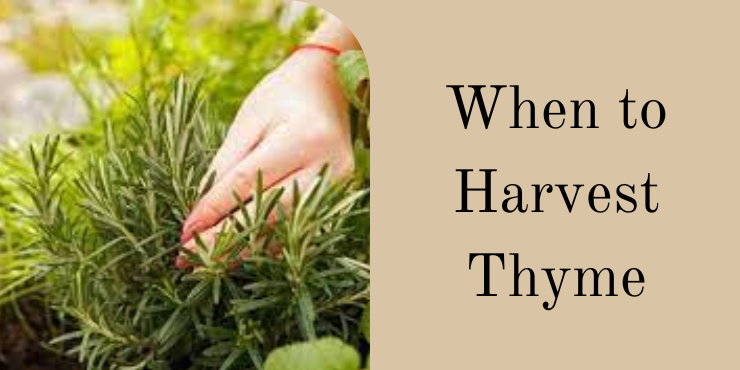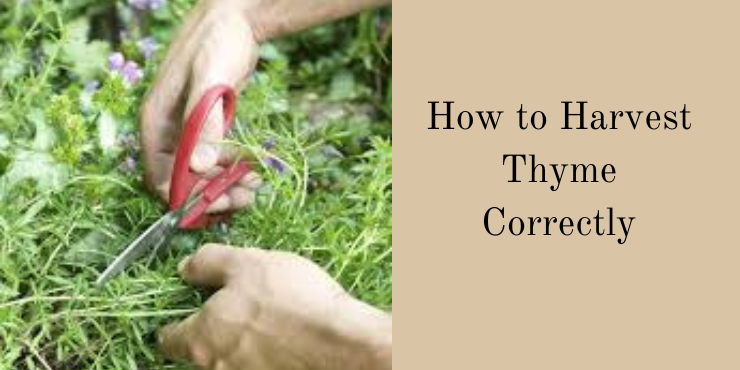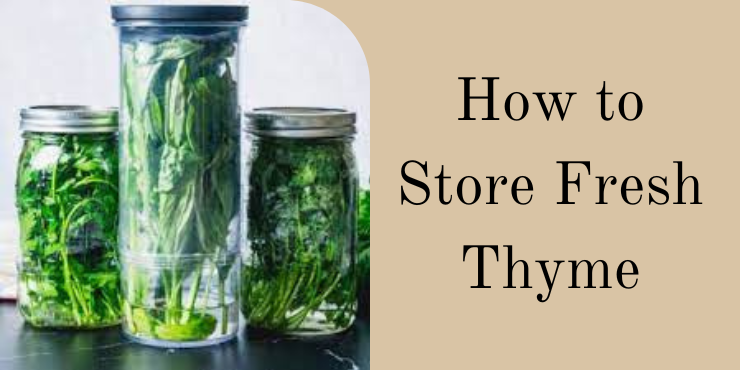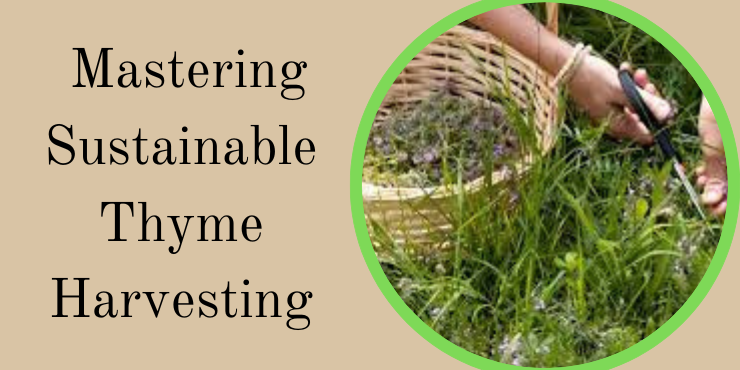Mastering Sustainable Thyme Harvesting
Mastering Sustainable Thyme Harvesting, Thyme, a fragrant and versatile herb, is a favorite among gardeners and culinary enthusiasts alike. Its delicate leaves and robust flavor make it a staple in various cuisines and herbal remedies. To ensure a continuous and bountiful harvest, it is crucial to adopt sustainable harvesting practices that allow you to enjoy thyme’s benefits without harming the plant. In this comprehensive guide, we will explore the art of harvesting thyme without jeopardizing its health and vitality.
When to Harvest Thyme

Knowing when to harvest thyme is crucial to ensure optimal flavor and preserve the health of the plant. Thyme, a versatile herb with aromatic leaves, is best harvested during its peak growth stage, typically in the spring and early summer when it is in full bloom. This is when the essential oils that contribute to its distinctive flavor and aroma are most concentrated.
To determine the ideal harvesting time, observe the plant for signs of robust growth and vibrant foliage. Aim to harvest when the leaves are at their freshest and just before or during the flowering stage, as this is when thyme’s flavor is most intense.
Mastering Sustainable Thyme Harvesting, Additionally, consider harvesting thyme in the morning when essential oil concentrations are highest. This not only enhances the flavor of the harvested thyme but also allows the plant to recover during the day, minimizing stress on its system.
Adopting a mindful approach to timing your thyme harvest ensures that you enjoy the herb at its flavorful best while promoting the overall health and longevity of the plant.
How to Harvest Thyme Correctly

Unlock the full potential of your thyme harvest with our comprehensive guide on how to harvest thyme correctly. Discover the secrets to preserving flavor, maximizing yield, and ensuring the health of your thyme plants.
In this detailed tutorial, we delve into the art of timing, showcasing the precise moment when thyme reaches its peak flavor and aroma. Learn to identify the perfect stage of growth for harvesting, whether you’re cultivating thyme in your garden or on your windowsill. We provide expert tips on recognizing the telltale signs that your thyme is ready for the scissors.
Precision is key, and our guide walks you through the tools and techniques required for a clean and efficient harvest. Explore the benefits of using sharp, clean scissors or pruning shears to prevent damage to the delicate leaves and encourage healthy regrowth. We emphasize the importance of harvesting responsibly to promote the long-term vitality of your thyme plants.
To ensure the longevity of your thyme harvest, we cover optimal drying and storage methods. Whether you prefer air-drying or using a dehydrator, we offer step-by-step instructions to preserve thyme’s essential oils and maintain its rich flavor profile. Discover the ideal storage conditions to keep your dried thyme fresh and potent for an extended period.
Mastering Sustainable Thyme Harvesting, Our guide also includes valuable insights into the frequency of harvesting, allowing you to strike the perfect balance between enjoying a bountiful harvest and promoting continuous growth. Learn about proper pruning techniques to encourage bushier, more robust thyme plants that will reward you with a continuous supply.
Harvesting thyme correctly is an art that enhances both the flavor of your dishes and the overall health of your herb garden. Whether you’re a seasoned gardener or a novice enthusiast, our guide provides a comprehensive roadmap to elevate your thyme harvesting skills and ensure a thriving herb garden for years to come.
Understanding Thyme Growth:
Before delving into the intricacies of harvesting, it’s essential to understand the growth patterns of thyme. Thyme is a hardy perennial herb that typically grows in low, spreading mounds. It features small, elliptical leaves densely packed on woody stems, and its compact nature makes it an excellent candidate for container gardening or planting in herb beds.
Thyme’s Adaptability:
One of the remarkable qualities of thyme is its adaptability to various climates and soil conditions. This adaptability, however, does not exempt it from the potential risks associated with improper harvesting. To maintain a thriving thyme plant, it is crucial to implement sustainable practices that prioritize the plant’s well-being.
Guidelines for Sustainable Thyme Harvesting:
Wait for the Optimal Growth Stage: Thyme is best harvested when it reaches its optimal growth stage. This is typically during the spring and early summer when the plant is in full bloom. Avoid harvesting more than one-third of the plant at any given time to ensure it can recover and continue producing new growth.
Use Sharp, Clean Tools: Employing sharp, clean scissors or pruning shears is vital for a clean and precise harvest. Dull or dirty tools can damage the plant, making it more susceptible to diseases and pests. Clean your tools before and after each use to prevent the spread of potential contaminants.
Focus on the Upper Growth: When harvesting thyme, concentrate on the upper portion of the plant where the newer growth is located. Snipping off the tender tips encourages bushier growth and helps the plant maintain its shape. Avoid cutting too close to the woody base, as this can hinder the plant’s ability to regenerate.
Harvest in the Morning: The morning is the optimal time for harvesting thyme. At this time, the essential oils that contribute to thyme’s flavor and aroma are most concentrated. Harvesting in the morning also allows the plant to recover during the day, minimizing stress on the plant.
Leave Some Growth Behind: It’s crucial to leave some foliage on the plant when harvesting. This ensures that the thyme can continue photosynthesizing and producing energy for future growth. Aim to leave at least two-thirds of the plant intact after each harvest.
Monitor Flowering Stages: Thyme produces small, delicate flowers that are not only attractive but also contribute to the plant’s overall health. Monitor the flowering stages and consider harvesting just before or during flowering to capture the maximum flavor and aroma.
Fertilize and Mulch: To support thyme’s growth and recovery after harvesting, provide adequate nutrients through organic fertilizers. Mulching around the base of the plant helps retain moisture, suppress weeds, and regulate soil temperature, creating optimal conditions for thyme to flourish.
How to Store Fresh Thyme

Storing fresh thyme properly is essential to preserve its flavor and aroma, ensuring that this versatile herb remains a delightful addition to your culinary endeavors. Here’s a simple guide on how to store fresh thyme to maximize its shelf life and maintain its vibrant essence:
Selection of Fresh Thyme: Start by choosing fresh thyme with vibrant green leaves and a robust fragrance. Avoid wilted or discolored bunches, as these may not stay fresh for as long.
Trimming and Cleaning: Before storage, trim any excess stems and remove wilted or yellow leaves. Gently rinse the thyme under cool running water to remove dirt or debris. Pat it dry with a paper towel to prevent excess moisture.
Paper Towel Wrap: One effective method is to wrap the cleaned and dried thyme in a slightly damp paper towel. Place the bundle in a plastic bag, leaving it partially open to allow some air circulation. The paper towel helps maintain the right level of moisture without causing the herb to become waterlogged.
Refrigeration: Fresh thyme is best stored in the refrigerator. Place the wrapped bundle in the vegetable crisper drawer. The cool, slightly humid environment will help prolong its freshness.
Herb Keeper: Consider investing in an herb keeper or a specialized container designed to extend the shelf life of herbs. These containers provide the ideal conditions for herbs, including ventilation and controlled humidity.
Freezing Thyme: Another option is to freeze fresh thyme. Strip the leaves from the stems and place them in an airtight container or a freezer bag. Alternatively, you can chop the leaves and freeze them in ice cube trays with a bit of water or olive oil.
Labeling and Dating: To keep track of freshness, label the storage container with the date of purchase or the date of preparation. This ensures you use the thyme within its optimal timeframe.
Regular Check-Up: Periodically check the thyme for any signs of wilting or decay. Remove any deteriorating leaves to prevent the spread of spoilage.
By following these steps, you can enjoy the full flavor and aromatic qualities of fresh thyme in your cooking for an extended period, enhancing the taste of various dishes.
Conclusion:
Harvesting thyme without killing the plant is an art that requires a delicate balance between reaping the benefits and preserving the plant’s vitality. By following these sustainable harvesting practices, you can enjoy a continuous harvest of fresh thyme while ensuring the long-term health and productivity of your thyme plant. Embrace these guidelines, and you’ll not only savor the rich flavors of thyme in your culinary creations but also contribute to the overall well-being of this resilient and aromatic herb.


